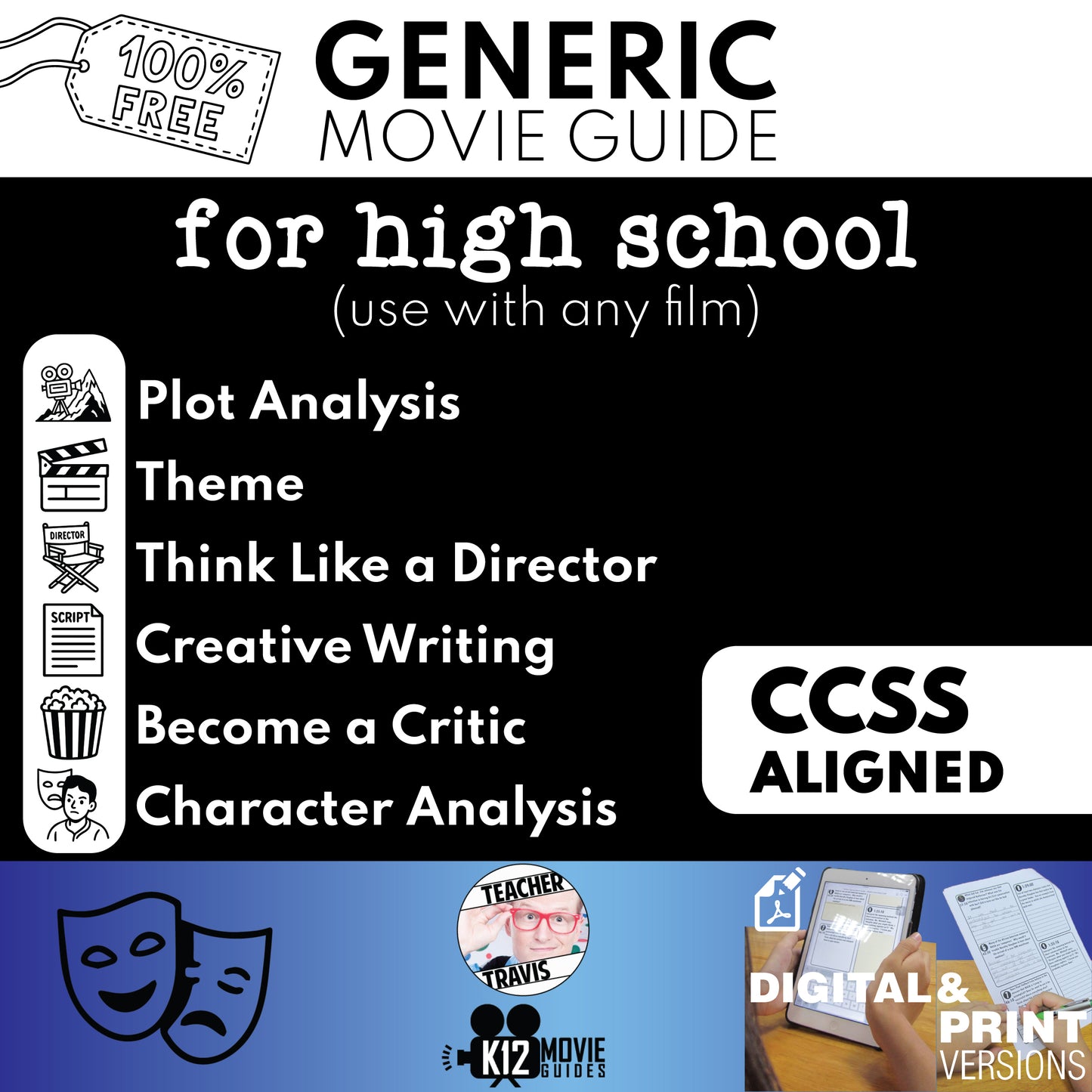K12 Movie Guides
Free Generic Movie Guide for Grades 9 to 12 High School Students (Works for Any Film) | Editable
Free Generic Movie Guide for Grades 9 to 12 High School Students (Works for Any Film) | Editable
Couldn't load pickup availability
This free, generic movie guide set works with any film your high school class watches—narrative features, literary adaptations, historical dramas, current-events documentaries, or long-form news specials. Includes printable PDF, editable DOCX, and a Google Doc link for digital use.
Two Versions Included
Fiction / Narrative Films
Focus on narrative structure (inciting incident, rising action, climax, denouement), character agency and arc, thematic claim, literary and cinematic devices, director’s choices (mise-en-scène), evidence-based critique, and creative transformations.
Real-Life / Historical / Documentary Films
Focus on timeline builder, documentary craft (interviews, narration, archival vs. reenactment, data/graphics), sourcing, corroboration, contextualization, claim testing (fact vs. fiction), filmmaker perspective and purpose, interview notes, lessons learned, and media literacy.
Flexible Use
- Movie length + 15 minutes: use the Stand-Alone Exit Reflection as a one-page synthesis after a full film, clip, or episode.
- Movie length + 30–45 minutes: complete Story Plot Tracker (fiction) or Timeline Builder (documentary) with 2–3 brief pauses, then finish with Movie Review or Most Important Moments.
- Movie length + 60–90 minutes: run KWL before viewing; during viewing complete Plot/Director/Devices (fiction) or Timeline/Director/Historian (documentary); after viewing write Thematic Claim or Lessons Learned, add Character Arc (fiction) or Perspective and Purpose (documentary), and choose one Creative Response.
Perfect For
- Secondary ELA, Media Studies, AP/IB English extensions
- U.S. History, World History, Civics, Current Events
- Common assessments for literary analysis and evidence-based argument writing
- Hybrid or remote learning with Google Classroom and sub-ready, structured movie days
What’s Included
Before Viewing (both versions)
- Film Facts (title, genre or mode, year/rating, key context and director)
- KWL chart (K: prior knowledge; W: guiding question or hypothesis; L: conclusions after viewing)
During Viewing — Fiction / Narrative
- Story Plot Tracker: Inciting Incident; Rising Action and complications; Crisis or Climax; Falling Action; Resolution or Denouement
- Think Like a Director: music and sound, color and palette, symbolic objects, shot and movement, lighting, editing and pacing, performance and blocking
- Literary Devices: foreshadowing; flashback or nonlinear structure; motif vs. leitmotif; symbolism and metonymy; irony; archetype, satire, parody; allusion and intertextuality; unreliable narrator
During Viewing — Historical / Documentary
- Timeline Builder: time or order number, what happened, who was involved, why it matters
- Think Like a Director: music and sound; style and colors; symbolic items; camera work; lighting; editing and pacing; interviews and narration; real footage vs. reenactment; data and graphics
- Think Like a Historian: sourcing; corroboration; contextualization; evaluating reliability and bias
- Interview Notes: who spoke, what they said, why it was important
- Fact vs. Fiction: event or claim; what the film shows; what your source says; same or different
After Viewing — Fiction / Narrative
- Thematic Claim: arguable thesis in one sentence with two to three precise scenes or techniques as evidence
- Character Arc: starting belief or goal; end state; because statements that explain the change
- Most Important Moments: reversal or twist; set-piece; most consequential choice and how each advances theme or arc
- Movie Review: claim and star rating; criteria such as acting, writing, design, sound, editing, coherence; two supporting scenes or techniques; recommendation and audience
- Transformative Response: choose one—Alternate POV Monologue or Three-Panel Storyboard with shot, lighting, color, and sound annotations
- Stand-Alone Exit Reflection: thematic claim with warrant; influential directorial choice; device and function; intertext or allusion; research extension question
After Viewing — Historical / Documentary
- Perspective and Purpose: maker and funding, central claim, intended audience and response, missing or minimized voices
- Lessons Learned: central claim with two to three warrants from the film; add corroboration when possible
- Movie Review: stars with rationale; two moments shaping understanding; one fact verified; recommendation
- Creative Response: choose one—Op-Ed response, one-page policy memo, or museum exhibit label for two artifacts or visuals
- Stand-Alone Exit Reflection: central claim, counterclaim or limitation, influential technique, most impactful interview or voice, verification plan
Formats Included
- Printable PDF
- Editable DOCX
- Google Doc link for easy assignment and sharing
CCSS Standards Alignment
Aligned with Common Core Anchor Standards (CCRA) for reading, writing, speaking and listening, and language. Students practice citing and evaluating evidence, analyzing structure and creator choices, crafting thematic claims and arguments, narrative or creative transformation, research extension, academic discussion and visual communication, and discipline-specific vocabulary in context.
Will This Work for Your Class?
If you need a lighter scaffold for younger learners, see the companion free generic movie guide for elementary and middle grades.
Share

